|
|
|
Sort Order |
|
|
|
Items / Page
|
|
|
|
|
|
|
| Srl | Item |
| 1 |
ID:
005414
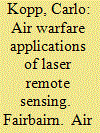

|
|
|
|
|
| Publication |
Fairbairn, Air Power Studies Centre, 1995.
|
| Description |
25p.
|
| Series |
Air Power Studies Centre papers; no.33
|
|
|
|
|
|
|
|
|
|
|
|
Copies: C:1/I:0,R:0,Q:0
Circulation
| Accession# | Call# | Current Location | Status | Policy | Location |
| 036773 | 358.4/KOP 036773 | Main | On Shelf | General | |
|
|
|
|
| 2 |
ID:
048618


|
|
|
|
|
| Publication |
Abu Dhabi, Emirates Center for Strategic Studies and Research, 1998.
|
| Description |
70p.
|
| Series |
Emirates lecture; no.14
|
|
|
|
|
|
|
|
|
|
|
|
Copies: C:1/I:0,R:0,Q:0
Circulation
| Accession# | Call# | Current Location | Status | Policy | Location |
| 040475 | 358.80953/EL- 040475 | Main | On Shelf | General | |
|
|
|
|
| 3 |
ID:
176735
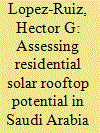

|
|
|
|
|
| Summary/Abstract |
The Saudi National Renewable Energy Program aims to substantially increase the share of renewable energy in the Kingdom's power generation mix. This study explores the extent to which solar rooftop deployment at the residential scale in Riyadh, could be cost-efficient and could accelerate decarbonization of in Saudi Arabia.
This study found that the maximum aggregate solar power capacity in Riyadh at the residential level would be around 400 MW. Also, the current residential electricity tariff does not incentivize photovoltaic (PV) solar rooftop deployment. Despite an increase in Saudi residential electricity prices in January 2018, rooftop solar PV cannot compete with electricity from the grid, even assuming aggressive reductions in the investment cost of solar technology.
|
|
|
|
|
|
|
|
|
|
|
|
|
|
|
|
| 4 |
ID:
098604


|
|
|
|
|
| Publication |
2010.
|
| Summary/Abstract |
A lack of access to energy and, in particular, electricity is a less obvious manifestation of poverty but arguably one of the most important. This paper investigates the extent to which electricity access can be investigated using night-time light satellite data and spatially explicit population datasets to compare electricity access between 1990 and 2000. We present here the first satellite derived estimates of rural population without access to electricity in developing countries to draw insights on issues surrounding the delivery of electricity to populations in rural areas. The paper provides additional evidence of the slow progress in expansion of energy access to households in Sub-Saharan Africa and shows how this might be ascribed in part due to the low population densities in rural areas. The fact that this is a continent with some of the lowest per-capita income levels aggravates the intrinsic difficulties associated with making the investments needed to supply electricity in areas with low population density and high dispersion. Clearly, these spatial dimensions of the distributions of the remaining unelectrified populations in the world have an impact on what options are considered the most appropriate in expanding access to these households and the relative attractiveness of decentralized options.
|
|
|
|
|
|
|
|
|
|
|
|
|
|
|
|
| 5 |
ID:
095454


|
|
|
|
|
| Publication |
New York, CRC Press, 2009.
|
| Description |
xxvii, 364p.
|
| Standard Number |
9781420082292
|
|
|
|
|
|
|
|
|
|
|
|
Copies: C:1/I:0,R:0,Q:0
Circulation
| Accession# | Call# | Current Location | Status | Policy | Location |
| 054870 | 304.20223/GAM 054870 | Main | On Shelf | General | |
|
|
|
|
| 6 |
ID:
051669
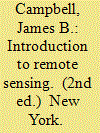

|
|
|
|
|
| Edition |
2nd ed.
|
| Publication |
New York, Guilford Press, 1996.
|
| Description |
xxvii, 622p.Hbk
|
| Standard Number |
14572300418
|
|
|
|
|
|
|
|
|
|
|
|
Copies: C:1/I:0,R:0,Q:0
Circulation
| Accession# | Call# | Current Location | Status | Policy | Location |
| 043339 | 621.3678/CAM 043339 | Main | On Shelf | General | |
|
|
|
|
| 7 |
ID:
167534


|
|
|
|
|
| Summary/Abstract |
Mangrove forests are among the most threatened ecosystems on earth. Some of these forests traverse national boundaries complicating their management due to differences in governance structures between countries. To improve the management of transboundary species regular monitoring is essential. Remotely sensed data were used to estimate forest cover and analyze conditions of mangroves in the proposed transboundary conservation area (TBCA) between Kenya and Tanzania. Image analysis was performed using unsupervised and supervised classification methods. The transboundary mangroves cover an estimated 11,906 ha; 55% being in Kenya, 45% in Tanzania. Ceriops tagal, Avicennia marina, and Rhizophora mucronata species co-dominate the mangroves of the transboundary area. The hotspot for loss and degradation of mangrove in the TBCA is Vanga in Kenya with a loss of 27 ha/yr. Harvesting of mangrove wood products have contributed to the loss of mangroves in the transboundary area. TBCA formation could play a critical role in ensuring sustainable mangrove resources utilization.
|
|
|
|
|
|
|
|
|
|
|
|
|
|
|
|
| 8 |
ID:
120188
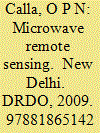

|
|
|
|
|
| Publication |
New Delhi, DRDO, 2009.
|
| Description |
viii,166p.pbk
|
| Series |
DRDO Monograph Series
|
| Standard Number |
9788186514221
|
|
|
|
|
|
|
|
|
|
|
|
Copies: C:1/I:0,R:0,Q:0
Circulation
| Accession# | Call# | Current Location | Status | Policy | Location |
| 057249 | 621.3678/CAL 057249 | Main | On Shelf | General | |
|
|
|
|
| 9 |
ID:
131028
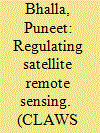

|
|
|
|
|
| Publication |
2014.
|
| Summary/Abstract |
The freedom of operations in space and of remote sensing by satellites has been globally accepted through different UN Conventions. Satellite imaging provides unrestricted access to areas transcending international borders and its commercialisation has resulted in the irrelevance of these borders even for distribution of data as commercial entities seek a larger and more diversi?ed customer base. Availability of such information commercially is enabling and in?uencing worldwide scienti?c, technological, social and economic advancements. However, its dual use potential that could provide disproportionate strategic and military advantages has raised concerns regarding the distribution. Differing interests have made regulating the sector a complex task. Nations that possess the capability want to strike a balance between their national security interests and foreign policy concerns, on the one hand, and commercial interests, on the other. At the same time, all nations remain apprehensive about the distribution of information about their area without their knowledge or consent.
|
|
|
|
|
|
|
|
|
|
|
|
|
|
|
|
| 10 |
ID:
152955


|
|
|
|
|
| Publication |
New Delhi, Viva Books, 2005.
|
| Description |
xxx, 288p.pbk
|
| Standard Number |
9788176496308
|
|
|
|
|
|
|
|
|
|
|
|
Copies: C:1/I:0,R:0,Q:0
Circulation
| Accession# | Call# | Current Location | Status | Policy | Location |
| 059065 | 621.3678/PAN 059065 | Main | On Shelf | General | |
|
|
|
|
| 11 |
ID:
157183


|
|
|
|
|
| Summary/Abstract |
This paper discusses whether current international and national regulation of remote sensing activities achieves a true balance between proprietary interests of producers of remote sensing data and information and the needs of the community in accessing that data and information. By subjecting remote sensing data to general copyright restrictions that are often coupled with exclusive licences, irrespective of type or use of data and/or information, the development of important secondary information markets could be negatively hampered. In the long run, over-regulating access to space data may prove counter-productive in the information age. Using examples of different modes of information dissemination currently being practised, the paper highlights the balances to be drawn between legal issues of private ownership of data and information and public good interests. It concludes with suggestions for a more coherent regulatory approach.
|
|
|
|
|
|
|
|
|
|
|
|
|
|
|
|
| 12 |
ID:
001851
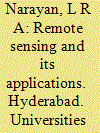

|
|
|
|
|
| Publication |
Hyderabad, universities Press, 1999.
|
| Description |
xii, 215p.
|
| Standard Number |
8173712689
|
|
|
|
|
|
|
|
|
|
|
|
Copies: C:3/I:0,R:0,Q:0
Circulation
| Accession# | Call# | Current Location | Status | Policy | Location |
| 042825 | 621.3678/NAR 042825 | Main | On Shelf | General | |
| 042826 | 621.3678/NAR 042826 | Main | On Shelf | General | |
| D42825 | 621.3678/NAR D42825 | Main | On Shelf | General | |
|
|
|
|
| 13 |
ID:
093268


|
|
|
|
|
| Publication |
London, Springer, 2009.
|
| Description |
xli, 297p.
|
| Standard Number |
9781402084836
|
|
|
|
|
|
|
|
|
|
|
|
Copies: C:1/I:0,R:0,Q:0
Circulation
| Accession# | Call# | Current Location | Status | Policy | Location |
| 054657 | 327.172/JAS 054657 | Main | On Shelf | General | |
|
|
|
|
| 14 |
ID:
121375


|
|
|
|
|
| Publication |
2013.
|
| Summary/Abstract |
Taking the city of Xiamen, China, as an example, we used thermal infrared remote sensing to detect thermal pollution, and examined its relationship to energy consumption and the industrial economy. Monthly changes in 2002 and dynamics throughout the period of rapid urbanization (1987-2007) are analysed. It is found that seasonal variation led to distinct shapes and sizes of thermal pollution areas, and winter thermal pollution was highly indicative of industrial and energy transformation sources. Industrial enterprises were the dominant sources of winter thermal pollution in Xiamen. The number and ratio of industrial thermal pollution sources increased stably in the earlier years, and dramatically in the later period (2002-2007), attributable to the effects of China entering the World Trade Organization. Linear regression shows that the number of thermal pollution sources was strongly correlated with several factors of the industrial economy and energy consumption, including industrial outputs, industrial enterprise numbers, LPG and electricity. Related mitigation measures are also discussed. This research builds a link between remote sensing-detected thermal pollution information and statistical energy consumption data, as well as industrial economy statistics. It thereby enhances understanding of the relationship between urbanization, industrialization, energy consumption and related environmental effects.
|
|
|
|
|
|
|
|
|
|
|
|
|
|
|
|
| 15 |
ID:
147527
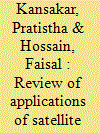

|
|
|
|
|
| Summary/Abstract |
Remotely sensed data can be used to understand and devise measures to address important global issues such as climate change, disaster and disease outbreak. National Aeronautics and Space Administration (NASA) is one of the largest producer and gatekeeper of satellite earth observation (EO) data that plays a crucial role in ensuring that these resources are used for solving global societal problems. However, the extent of remote sensing application is highly disparate in different parts of the world. This paper provides a general overview of key societal applications that have been enabled globally with the use of EO data. It also summarizes the impact of various NASA-supported programs for promoting applications on the targeted beneficiary communities. The themes addressed here are land cover/land use mapping, carbon biomass assessment, food security, disaster management, water resources, ocean management and health and air quality. The paper also argues for capacity building that is crucial to building sustainable solutions when using EO data for science-based decision making.
|
|
|
|
|
|
|
|
|
|
|
|
|
|
|
|
| 16 |
ID:
148634
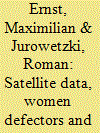

|
|
|
| 17 |
ID:
042346
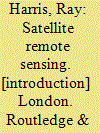

|
|
|
|
|
| Publication |
London, Routledge & Kegan Paul, 1987.
|
| Description |
xix, 220p.Hbk
|
| Standard Number |
0710203055
|
|
|
|
|
|
|
|
|
|
|
|
Copies: C:1/I:0,R:0,Q:0
Circulation
| Accession# | Call# | Current Location | Status | Policy | Location |
| 029440 | 621.3678/HAR 029440 | Main | On Shelf | General | |
|
|
|
|
| 18 |
ID:
169303
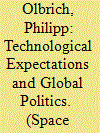

|
|
|
|
|
| Summary/Abstract |
Media, industry, and academia frequently depict the commercialization of satellite imagery as geospatial revolution with transformational effects on global politics. In doing so, they follow an understanding that isolates technology from politics. While this division is still prevalent in international relations, recent scholarship has promoted the intricate relationship of technology with politics as socio-material. Adding to this literature, I draw on the sociology of expectations to propose an alternative reading of nongovernmental remote sensing. For this purpose, the notion of technopolitical barriers is introduced to trace controversies about technological expectations of satellite imagery. Based on expert interviews and document analysis, I identify three waves of enthusiasm, which are characterized by particularly salient expectations and techno-political barriers. The first wave is fueled by an enthusiasm about the general benefits of visual transparency as opposed to Cold War secrecy. The second wave turns toward nongovernmental imagery intelligence for human security. In the third wave, satellite imagery joins multiple data streams to support political and business decisions. Taken together, the three-wave model distorts the linear understanding of a revolutionary development but reveals the political and controversial nature of the ongoing commercialization of satellite imagery. As a part of this, nongovernmental remote sensing has experienced a focus shift from visual transparency toward geospatial big data. Moreover, the three-wave model highlights the persistence of expectations and techno-political barriers in the nongovernmental sector with important implications for policymaking and the global impact of commercial satellite imagery.
|
|
|
|
|
|
|
|
|
|
|
|
|
|
|
|
| 19 |
ID:
142046


|
|
|
|
|
| Summary/Abstract |
Does economic inequality cause civil war? Deviating from individualist measures of inequality such as the Gini coefficient, recent studies have found a statistical link between group-level inequalities and conflict onset. Yet, this connection remains controversial, not least because of the difficulties associated with conceptualizing and measuring group-level differences in development. In an effort to overcome weaknesses afflicting specific methods of measurement, we introduce a new composite indicator that exploits the strengths of three sources of data. The first step of our method combines geocoded data from the G-Econ project with night lights emissions data from satellites. In a second step, we bring together the combined spatial values with survey estimates in order to arrive at an improved measure of group-level inequality that is both more accurate and more robust than any one of the component measures. We evaluate the effect of the combined indicator and its components on the onset of civil violence. As expected, the combined index yields stronger results as more information becomes available, thus confirming the initial hypothesis that horizontal economic inequality does drive conflict in the case of groups that are relatively poor compared to the country average. Furthermore, these findings appear to be considerably more robust than those relying on a single data source.
|
|
|
|
|
|
|
|
|
|
|
|
|
|
|
|
| 20 |
ID:
073822
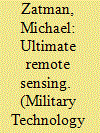

|
|
|
|
|
|
|
|